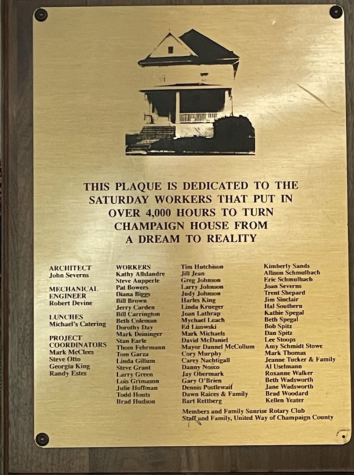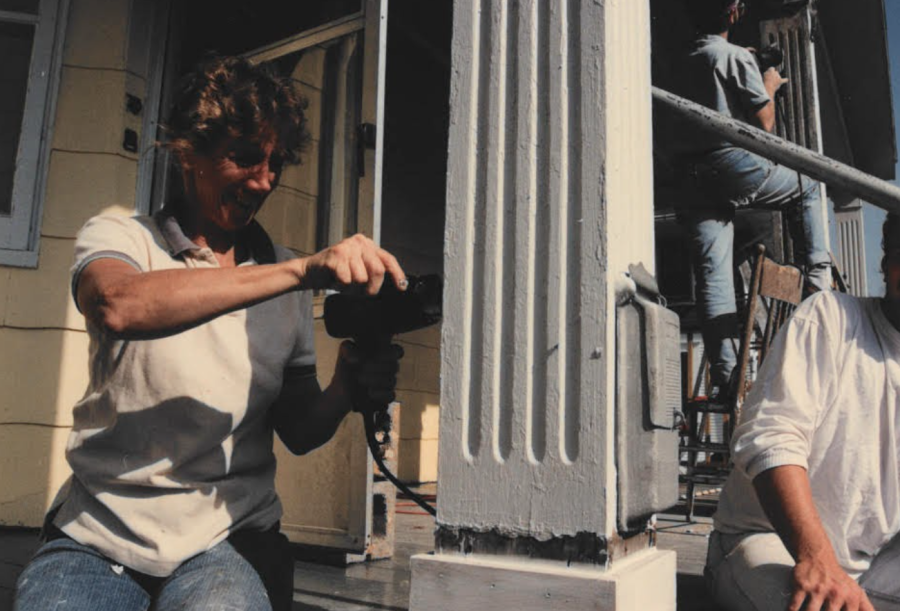Champaign House provides refuge for those with HIV
Photo courtesy of Jerry Carden
Georgia King, local AIDS activist, works on a pillar of the Champaign House. The House provides a place for those with HIV to stay who don’t have other housing options.
Feb 16, 2022
Established in the early 1990s, Champaign House was the first center in downstate Illinois devoted to housing people living with HIV.
Today, the transitional housing facility continues to provide shelter for people living with HIV who are homeless.
Members of the local gay community formed the Greater Community AIDs Project in 1985 to provide support services for people living with HIV and to provide AIDS education to the community.

Originally, GCAP was known as the Gay Community AIDS Project, yet the organization broadened its title in the 1990s to recognize HIV’s ability to affect anyone, not just gay white men.
Jerry Carden, an original member of GCAP, said that at the beginning of the epidemic, there were no tests to detect the disease. He said many people who had AIDS early on in the epidemic were “very, very debilitated by the time they were diagnosed.”
Get The Daily Illini in your inbox!
“By the time people were diagnosed, they shortly after — or maybe even before they were diagnosed — they maybe had to quit working,” Carden said. “So maybe, they had to give up an apartment because they could no longer work and pay the rent.”
He said it became obvious that those diagnosed with HIV were losing their housing.
“We (GCAP) decided that we could get a house that would provide housing for people,” Carden said. “The original goal was to provide temporary housing until they could find some other solution.”
He said that’s when the idea for Champaign House was born.
The Champaign House was originally built in 1904, according to Mike Benner, executive director of GCAP.
Volunteers from GCAP remodeled the two-story building into a house with five bedrooms, a full kitchen, a kitchenette, two full baths and one living room. The renovation took two years, and the transitional housing facility opened in 1993.
Benner said the House is located in a residential neighborhood and resembles a regular two-story house. Its central location, he said, allows residents to have easy access to public transportation.
During the House’s renovation, Carden said the volunteers often met on Saturdays to help with the remodel. He said the crew often called them “work parties” because volunteers worked together for a common cause.
Benner and Carden accredited Georgia King, a local AIDS activist, for her contribution to Champaign House. Benner described her as “the mother of GCAP.”
“She was there every weekend helping work on the project,” Benner said. “If it wouldn’t have been for her fortitude and ambition and motivation, then Champaign House would have never come into fruition.”

(Photo courtesy of Mike Benner)
Benner said the Champaign House received its funding from community donations and the Prairie AIDS Foundation. Currently, it’s funded primarily through grants from the state of Illinois.
Benner added that the Champaign House currently serves as a safe refuge for those who are living with HIV and homeless. He said people with HIV/AIDS deal with numerous health concerns, and many experience homelessness.
“With any population, it’s kind of hard work to take care of your health care needs if you don’t know where you’re going to be sleeping,” Benner said.
Benner said the location of Champaign House is confidential to protect the identities of its residents and their HIV statuses. He said this practice dates back to the early days of the AIDS epidemic when HIV was considered taboo.
Unfortunately, there is still a lot of stigma surrounding HIV, he said.
“If we can eliminate that one barrier that individuals in the house have, that’s one of the things we can do,” Benner said.
During residents’ stay at Champaign House, GCAP offers them case management services to minimize barriers to permanent housing.
Benner said case managers have weekly meetings with clients to establish goals, facilitate medical appointments and help with residents’ job searches.
He said residents are also taught life skills that they maybe didn’t have access to previously.
“This is giving them an opportunity to hone those skills so they can live independently,” Benner said. “Being homeless is a major, major challenge. When you’re put in that situation, just trying to even get your bearings can be kind of difficult. So it’s always nice to have somebody there that can help you through that process.”






